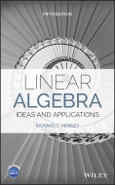Praise for the Third Edition
"This volume is ground-breaking in terms of mathematical texts in that it does not teach from a detached perspective, but instead, looks to show students that competent mathematicians bring an intuitive understanding to the subject rather than just a master of applications."
- Electric Review
Learn foundational and advanced topics in linear algebra with this concise and approachable resource
A comprehensive introduction, Linear Algebra: Ideas and Applications, Fifth Edition provides a discussion of the theory and applications of linear algebra that blends abstract and computational concepts. With a focus on the development of mathematical intuition, the book emphasizes the need to understand both the applications of a particular technique and the mathematical ideas underlying the technique.
The book introduces each new concept in the context of explicit numerical examples, which allows the abstract concepts to grow organically out of the necessity to solve specific problems. The intuitive discussions are consistently followed by rigorous statements of results and proofs. Linear Algebra: Ideas and Applications, Fifth Edition also features:
- A new application section on section on Google’s Page Rank Algorithm.
- A new application section on pricing long term health insurance at a Continuing Care Retirement Community (CCRC).
- Many other illuminating applications of linear algebra with self-study questions for additional study.
- End-of-chapter summaries and sections with true-false questions to aid readers with further comprehension of the presented material
- Numerous computer exercises throughout using MATLAB code
Linear Algebra: Ideas and Applications, Fifth Edition is an excellent undergraduate-level textbook for one or two semester undergraduate courses in mathematics, science, computer science, and engineering. With an emphasis on intuition development, the book is also an ideal self-study reference.
Table of Contents
Preface xi
Features of the Text xiii
Acknowledgments xvii
About the Companion Website xviii
1 Systems of Linear Equations 1
1.1 The Vector Space of m × n Matrices 1
The Space ℝn 4
Linear Combinations and Linear Dependence 7
What Is a Vector Space? 11
Why Prove Anything? 15
Exercises 16
1.1.1 Computer Projects/Exercises/Exercises 22
Exercises 24
1.1.2 Applications to Graph Theory I 25
Exercises 27
1.2 Systems 27
Rank: The Maximum Number of Linearly Independent Equations 34
Exercises 37
1.2.1 Computer Projects/Exercises 39
Exercises 39
1.2.2 Applications to Circuit Theory 40
Exercises 44
1.3 Gaussian Elimination 46
Spanning in Polynomial Spaces 56
Computational Issues: Pivoting 59
Exercises 60
1.3.1 Using tolerances in MATLAB’s rref and rank 66
Using Tolerances in rref and Rank 66
Exercises 67
1.3.2 Applications to Traffic Flow 68
Exercises 70
1.4 Column Space and Nullspace 71
Subspaces 74
Exercises 82
1.4.1 Computer Projects/Exercises 89
Exercises 90
Chapter Summary 91
2 Linear Independence and Dimension 93
2.1 The Test for Linear Independence 93
Bases for the Column Space 100
Testing Functions for Independence 102
Exercises 104
2.1.1 Computer Projects/Exercises 108
Exercises 108
2.2 Dimension 109
Exercises 118
2.2.1 Computer Projects/Exercises 123
Exercises 123
2.2.2 Applications to Differential Equations 125
Exercises 128
2.3 Row Space and the Rank-Nullity Theorem 128
Bases for the Row Space 130
Computational Issues: Computing Rank 138
Exercises 140
2.3.1 Computer Projects/Exercises 143
Exercises 143
Chapter Summary 144
3 Linear Transformations 147
3.1 The Linearity Properties 147
Exercises 155
3.1.1 Computer Projects/Exercises 160
Exercises 161
3.2 Matrix Multiplication (Composition) 162
Partitioned Matrices 169
Computational Issues: Parallel Computing 171
Exercises 171
3.2.1 Computer Projects/Exercises 177
3-D Computer Graphics 177
Exercises 177
3.2.2 Applications to Graph Theory II 178
Exercises 180
3.2.3 Computer Projects/Exercises 180
Google’s Page Rank Algorithm 180
Exercises 183
3.3 Inverses 184
Computational Issues: Reduction versus Inverses 190
Exercises 192
3.3.1 Computer Projects/Exercises 197
Ill-Conditioned Systems 197
Exercises 197
3.3.2 Applications to Economics: The Leontief Open Model 199
Exercises 204
3.4 The LU Factorization 205
Exercises 213
3.4.1 Computer Projects/Exercises 216
Exercises 216
3.5 The Matrix of a Linear Transformation 217
Coordinates 217
Application to Differential Equations 225
Isomorphism 228
Invertible Linear Transformations 229
Exercises 231
3.5.1 Computer Projects/Exercises 236
Graphing in Skewed-Coordinates 236
Exercises 236
3.5.2 Computer Projects/Exercises 237
Pricing Long Term Health Care Insurance 237
Exercises 242
Chapter Summary 242
4 Determinants 245
4.1 Definition of the Determinant 245
4.1.1 The Rest of the Proofs 252
Exercises 256
4.1.2 Computer Projects/Exercises 258
4.2 Reduction and Determinants 259
Exercises 266
4.2.1 Volume 268
Exercises 271
4.3 A Formula for Inverses 271
Exercises 275
Chapter Summary 276
5 Eigenvectors and Eigenvalues 279
5.1 Eigenvectors 279
Exercises 288
5.1.1 Computer Projects/Exercises 291
Exercises 291
5.1.2 Application to Markov Chains 291
Exercises 294
5.2 Diagonalization 295
Powers of Matrices 297
Exercises 299
5.2.1 Application to Systems of Differential Equations 301
Exercises 304
5.3 Complex Eigenvectors 304
Complex Vector Spaces 311
Exercises 312
5.3.1 Computer Projects/Exercises 314
Exercises 314
Chapter Summary 314
6 Orthogonality 317
6.1 The Scalar Product in ℝn 317
Orthogonal/Orthonormal Bases and Coordinates 321
Exercises 326
6.2 Projections: The Gram-Schmidt Process 328
The QR Decomposition 334
Uniqueness of the QR Factorization 337
Exercises 338
6.2.1 Computer Projects/Exercises 341
Exercises 342
6.3 Fourier Series: Scalar Product Spaces 342
Exercises 350
6.3.1 Computer Projects/Exercises 353
Exercises 354
6.4 Orthogonal Matrices 355
Householder Matrices 360
Exercises 364
6.4.1 Computer Projects/Exercises 369
Exercises 369
6.5 Least Squares 370
Exercises 377
6.5.1 Computer Projects/Exercises 380
Exercises 380
6.6 Quadratic Forms: Orthogonal Diagonalization 381
The Spectral Theorem 384
The Principal Axis Theorem 385
Exercises 392
6.6.1 Computer Projects/Exercises 394
Exercises 395
6.7 The Singular Value Decomposition (SVD) 396
Application of the SVD to Least-Squares Problems 402
Exercises 404
Computing the SVD Using Householder Matrices 406
Diagonalizing Matrices Using Householder Matrices 408
6.8 Hermitian Symmetric and Unitary Matrices 409
Exercises 416
Chapter Summary 418
7 Generalized Eigenvectors 421
7.1 Generalized Eigenvectors 421
Exercises 429
7.2 Chain Bases 431
Jordan Form 438
Exercises 443
The Cayley-Hamilton Theorem 444
Chapter Summary 445
8 Numerical Techniques 447
8.1 Condition Number 447
Condition Number 449
Least Squares 452
Exercises 453
8.2 Computing Eigenvalues 454
Iteration 454
The QR Method 458
Exercises 464
Chapter Summary 465
Answers and Hints 467
Index 491








